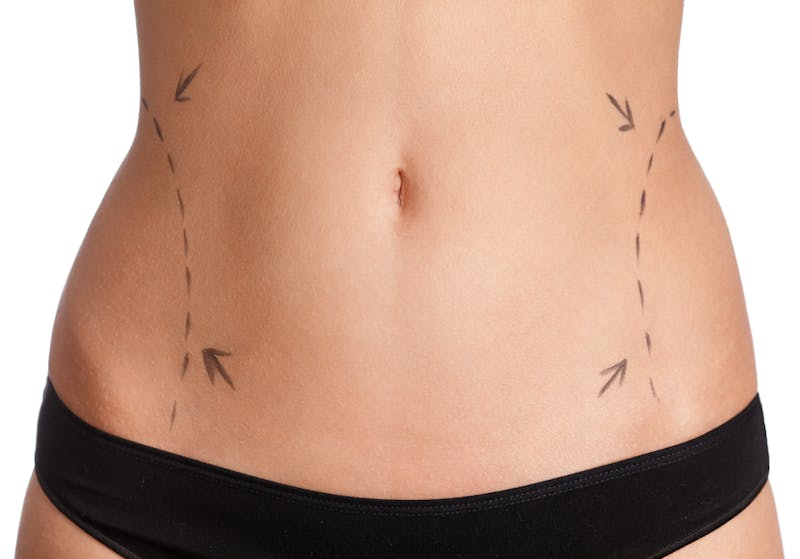
Conveniently located in the heart of the Rio Grande Valley, Rios Center for Plastic Surgery in Edinburgh, TX is committed to helping clients in the RVG area achieve their ideal aesthetic. To tackle the common problem of excess stubborn fat, we proudly offer VASER liposuction, a game-changing lipo technique. Today, we reveal everything you need to know.
How Long Does VASER Liposuction Take?
The length of your VASER liposuction procedure depends on several factors, including the size of the areas being treated, the number of areas being treated, how much fat is in the targeted areas, and how much fat needs to be removed from the targeted areas.
During your initial consultation, we will review your current body fat distribution and aesthetic goals to determine how long your procedure will take. On average, you will need an hour per treated area. Therefore, if you are having fat removed from your chest and abdomen, your procedure will take around two hours.
How Does This Compare to Laser Liposuction?
Comparing VASER liposuction to laser liposuction is like comparing apples and oranges. The thermal energy used during VASER liposuction is so focused that it liquefies fat much faster than laser liposuction can.
This means you will be done with your procedure much faster than you could with laser lipo and you can enjoy much more dramatic results. The best part? Despite its lightning speed, the liquefied fat cells can be transferred to the buttocks to help you further sculpt your ideal contour.
How Does This Compare to Traditional Liposuction?
Again, you can’t really make a good comparison between VASER liposuction and traditional lipo. While your VASER liposuction procedure may take two hours, you are treating two large regions of your body.
With traditional lipo, your procedure will easily take three to four hours to treat to regions and then you need to be observed for one to three hours post-op. If you’re removing fat from two areas, your entire procedure from admission to discharge can easily take you eight hours.
What Can I Expect During the Procedure?
What to expect during your procedure depends on your health, budget, and the results you are looking for. If you’re looking for more dramatic results, your procedure will be more extensive and you will be placed under general anesthesia if you are healthy enough. Otherwise, you will be placed under local anesthesia and oral sedation.
The bottom line is we will ensure you are asleep and pain-free throughout your entire procedure. Once you are asleep, a saline solution is injected into the targeted region to break up the fat cells. Then, they will be liquefied via vibration amplification of sound energy at resonance (VASER). Finally, they will be suctioned out.
What Areas Can Be Treated?
This is a tricky question to answer. On paper, virtually any part of your body can be treated with this liposuction technique. In practice, there is a Goldilocks’s zone where you have to have enough excess fat to be removed but not too much fat. A general rule of thumb is you should have at least an inch of pinchable fat for a region to qualify.
The most common areas where women have fat removed are the upper and lower abdomen, back, inner and outer thighs, upper arms, and underarms. Men tend to seek this procedure to remove excess fat from the buttocks, chest, calves, flanks, chin and neck.
How Much Fat Is Too Much?
To determine if you have too much fat to treat, it is important to come in for an initial consultation. Without taking your measurements, we can say that if you are under 31 pounds away from your goal weight, there is a good chance you don’t have too much fat in a given region for treatment.
There are a couple of problems with trying to remove too much fat. First, this procedure can only remove around a quarter of the fat cells in a given region. If you have too much fat to be removed, you may not be satisfied with the results of the procedure. Second, if too much fat is removed, you may have to deal with loose, sagging skin.
How Long Does Recovery Take?
Everyone recovers from VASER liposuction procedures at different rates. However, on average, it only takes four to seven days to mostly recover from this procedure. After the one-week mark, you are free to return to a sedentary job. After the two-week mark, you are free to return to a manual labor job. After six weeks, you may resume strenuous workouts.
How Long Will it Take to See the Results?
The results of the procedure are immediate. The excess fat cells in the treatment area are destroyed over the course of the procedure and suctioned out using a medical-grade suction device. Unlike alternative fat removal treatments, there is no waiting up to six months for your body to flush out the dead fat cells.
With that being said, it can take between one and six months to see the final results of the procedure. This is because it takes your skin time to snap into its appropriate position. To increase the rate at which you will see results, stay hydrated, protect your skin from the sun, don’t smoke, don’t drink and eat plenty of protein, fruits and vegetables.
How Long Do the Results Last?
The results of this procedure are considered permanent. Adults cannot grow new fat cells. Therefore, when excess fat cells are removed from the body, there are permanently fewer fat cells in the treated area. However, if you regain a significant amount of fat, you may find that the fat cells remaining in the treated area expand and you need a follow-up procedure.
How Can I Maintain the Best Results?
The only way to maintain the best results after this procedure is to maintain your weight. As you age, your metabolism will slow due to hormonal changes. However, you should try your hardest to not gain more than 10 pounds. If you notice you are gaining weight consistently, try to focus on your diet, cardio routine and resistance training routine.
Diet
If you notice that you are gaining weight consistently, the first thing you should look at is your diet. Have you started drinking more soda, juice or alcohol lately? Remember, liquid calories count. You could even say that they count more than solid calories because they provide little-to-no nutritional value and don’t fill you up.
Your diet should be the first thing you look at when you notice fat gain because it is simple to substitute caloric-dense foods for foods that are less dense in calories. It is also a lot easier to control your portion sizes than it is to add an extra hour of exercise per day to make up for the extra slice of pizza you’ve started eating.
Cardio
According to the American Heart Association (AHA) and the Centers for Disease Control and Prevention (CDC), adults should engage in at least 2.5 hours of moderate-intensity cardio or 1.25 hours of high-intensity cardio every week. If you are actively trying to lose weight, double these recommendations to get the cardio you should shoot for.
Examples of moderate-intensity cardio include walking, jogging, running, cycling, swimming or rowing at a pace that allows you to hold a comfortable conversation during exercise. Your heart rate never passes half of your maximum beats per minute (220 minus your age). Moderate-intensity exercises may be performed at a vigorous level of intensity (50% to 80% max BPM).
Resistance Training
If you find that you are gaining weight, your metabolism may be slowing because you are losing muscle mass. Whether your goal is to preserve your muscle mass or build muscle mass, you should be resistance training at least three times per week. If you don’t know how to create a workout routine, seek a certified personal trainer to help you.
If you’re new to resistance training, start with three sets of 10 repetitions of light weights when learning a new exercise. You may even want to film yourself performing the motion without weights and then comparing your form to a professional trainer on YouTube. Once you have the motion down, you can start adding heavier weight and reducing your repetitions.
Am I a Good Candidate for This Procedure?
There are many factors that affect someone’s candidacy for this procedure. For instance, it is pretty important that you have fairly elastic skin. This is because when you lose a significant amount of fat, your skin needs to be healthy enough to snap back into a tighter position. Here are a few other signs you may be a good candidate for this procedure:
You Don’t Smoke
To be a good candidate for any aesthetic procedure, it is important that you do not smoke. Cigarettes, and smoking cessation tools, contain nicotine. Nicotine is a chemical compound that constricts the blood vessels. This blood vessel constriction leads to elevated blood pressure. Elevated blood pressure is not ideal for anyone being put under anesthesia or sedation.
Moreover, nicotine destroys existing collagen and slows your skin’s production rate of new collagen. Strong, healthy, plentiful collagen is particularly important for fat removal procedures so your skin can tighten up quickly and you can see the final results of your procedure sooner. For this reason, you can’t smoke within six weeks of your procedure.
You Don’t Drink Alcohol
The best candidate for this procedure does not drink alcohol. If you do drink alcohol, abstain in the six weeks leading up to the procedure. This ensures that the skin (and body) are properly hydrated and nourished. Because of alcohol’s diuretic properties, when you imbibe, you flush out essential nutrients.
An equally important reason to not drink alcohol before this procedure also has to do with alcohol’s diuretic properties. When you flush out an excessive amount of water and become dehydrated, your circulatory system cannot operate as efficiently and your blood pressure rises. There is a chance that your blood pressure will increase to an unhealthy level.
You Aren’t Pregnant or Nursing
Your health and safety are two of our top priorities. That is why we only offer FDA-approved aesthetic procedures. However, the FDA has neither tested nor approved this procedure for pregnant or nursing women. For that reason, you must wait until you are no longer pregnant or nursing to consider this procedure.
You’re Done Having Children
Your satisfaction is also very important to us. Therefore, we recommend this procedure to women who believe they are done having children and men. Nearly all pregnancies result in fat gain. While there’s nothing wrong with gaining fat during your pregnancy, if you gain too much, you may end up dissatisfied with the results of the procedure.
Even though your body can’t grow new fat cells, the fat cells that remain in your body will still expand if you consume more calories than your body needs for fuel. This expansion of fat cells can happen anywhere, including in the areas you have removed excess fat from.
You’re Within 30 Pounds of Your Goal Weight
VASER lipo is fairly unique in that it uses energy to break apart your fat cells. This energy encourages your skin to produce collagen, which tightens the skin. However, if you lose over 30 pounds after treatment, you may have loose skin. Therefore, we only recommend this procedure to clients who are within 30 pounds of their ideal weight.
Learn More About How to Sculpt the Body of Your Dreams Today
If you want to quickly, comfortably and efficiently sculpt the body of your dreams, you may be the perfect candidate for VASER liposuction. This technique is far faster and more effective than any other liposuction technique, including laser liposuction.
To learn more about this life-changing body contouring procedure, contact us today at Rios Center for Plastic Surgery in Edinburg, TX to schedule your initial consultation. We can’t wait to meet you.
Back to Blog

